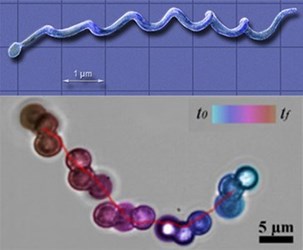"Microswimmer" Robots Designed To Drill Through Blocked Arteries

New technology could provide an alternative to stenting and angioplasty.
Drexel University engineers have developed a method to repair blocked arteries by using tiny, corkscrew-shaped robots to drill through blockages and restore blood flow. The researchers believe this approach could be significantly more effective than current clinical standards, and could require a shorter recovery time.
The technology uses chains of three or more iron oxide beads that are held together by chemical bonds and magnetic force. The chains are propelled through the body using an external magnetic field, which causes each bead to rotate independently and the entire chain to revolve like a corkscrew. According to Drexel Now, the longer the chain, the faster it can travel to the occluded artery and plow through the blockage.
The complete procedure, as proposed by Drexel’s Biological Actuation Sensing and Transport Laboratory (BASTLab), would use the smaller millirobots to start chipping away at the blockage. Then, a larger drill, designed by Bradley Nelson of ETH Zurich, would finish the job. Finally, the robots would deliver anti-coagulant drugs to the affected area before dispersing into the body.
“The microswimmers are composed of inorganic biodegradable beads so they will not trigger an immune response in the body,” said MinJun Kim, BASTLab director. “And we can adjust their size and surface properties to accurately deal with any type of arterial occlusion.”
According to Kim, the inspiration for the technology came from Borrelia burgdorferi, the bacteria that cause Lyme disease, which burrow into healthy tissue and cause destruction. By turning that same kind of burrowing on arterial blockages, Drexel scientists hope to provide a revolutionary tool for vascular surgeons.
Current clinical standards address narrowed arteries by placing a stent or performing a balloon angioplasty. In some cases, surgeons have to perform a bypass, rerouting blood around the blockage.
“Current treatments for chronic total occlusion are only about 60 percent successful,” Kim told Drexel Now. “We believe that the method we are developing could be as high as 80 to 90 percent successful and possibly shorten recovery time.”
In a study published in the Journal of Nanoparticle Research, researchers noted that micro- and nanoscale robots were “very promising to significantly enhance the performance of particulate drug delivery by providing high accuracy at extremely small scales.”
According to the Mayo Clinic, the greater precision and control offered by microrobotics — which leads to reduced risk of infection, smaller scars and quicker recovery — has scientists investigating possible applications for their use in a number of different procedures. For example, research presented recently by the University of Houston proposes using microrobotics to make brain surgery less invasive.
Drexel’s BASTLab will receive part of an $18 million international research grant from the Korea Evaluation Institute of Industrial Technologies (KEIIT), which aims to have a micro-robot-assisted procedure for treating blocked arteries within five years.
According to Kim, the KEIIT project is enormously valuable to a microrobotics field that remains very much in its infancy. “A project like this, because it is supported by leading institutions and has such a challenging goal, is an opportunity to push both medicine and microrobotics into a new and exciting place,” he said.
